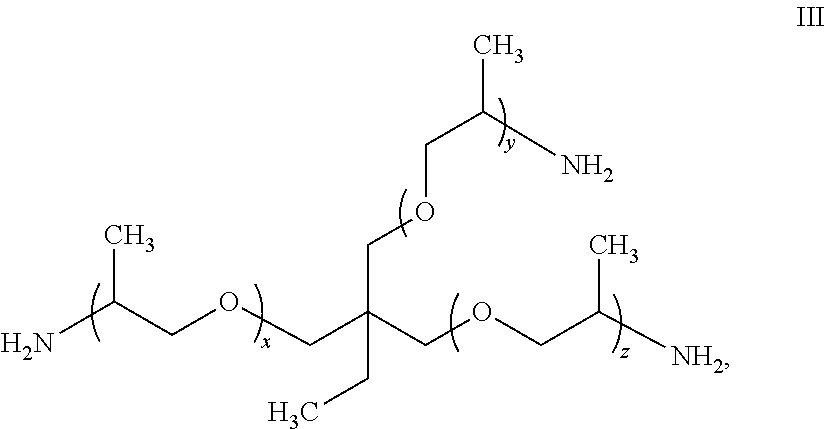Water-soluble polyamide polymer and use thereof as functional additive
a polymer and water-soluble technology, applied in the field of polymer, can solve the problems of affecting the mechanical strength of hair fibres, affecting the service life of hair fibres,
- Summary
- Abstract
- Description
- Claims
- Application Information
AI Technical Summary
Benefits of technology
Problems solved by technology
Method used
Image
Examples
example 1
ynthesis According to the Invention, Itaconic Acid / Ethylene Diamine, Molar Ratio 1.01:1, no Solvent
[0079]In a 2 liter, 5 neck-flask equipped with a nitrogen inlet, thermocouple, overhead stirrer, reflux condenser and load neck, were charged 195 g of ethylene diamine. Subsequently, 426.7 g of itaconic acid were added in portions of 106.7 g every 5 minutes (1.01:1 molar ratio). During the addition of the itaconic acid was observed a considerable increase in temperature (from room temperature to 160° C.) and the suspension like mixture turned into a viscous paste. After the addition of the last portion, due to the high temperature the polycondensation started and there was the formation of water inside the flask (foam creation and the temperature reduction was observed). To promote the reaction of polycondensation the mixture was heated to 175° C. under nitrogen flow and the reflux condenser was replaced by a distillation column. Starting from reaching the set temperature of 175° C. th...
example 2
ynthesis According to the Invention, Itaconic Acid / Polyether Amine (Jeffamine® D-230), Molar Ratio 1:1, no Solvent
[0081]In a 250 mL, 4 neck-flask equipped with a nitrogen inlet, thermocouple, overheadstirrer and reflux condenser, were charged 57.5 g of Jeffamine® D-230. Subsequently, 32.5 g of itaconic acid were added in two equal portions (1:1 molar ratio) within 30 minutes. During the addition of the first itaconic acid portion a slight increase in temperature (from room temperature to 50-60° C.) was observed and after the addition of the second itaconic acid portion the now suspension like mixture showed a further exo-thermic temperature increase to about 120° C. and slight foam creation was observed. To promote the reaction of polycondensation the mixture was heated to 170° C. under nitrogen flow and the reflux condenser was replaced by a distillation column. Starting from reaching the set temperature of 170° C. the reaction occurred for about 3 h to achieve total conversion. Af...
example 3
ynthesis According to the Invention, Itaconic Acid / Polyether Amine (Jeffamine® ED-900), Molar Ratio 1:1, no Solvent
[0083]In a 250 mL, 4 neck-flask equipped with a nitrogen inlet, thermocouple, overheadstirrer and reflux condenser, were charged 90 g of Jeffamine® ED-900. Subsequently, 13 g of itaconic acid were added. During the addition of itaconic acid only a slight increase in temperature (from room temperature to 30-40° C.) was observed. To promote the reaction of polycondensation the mixture was heated to 180° C. under nitrogen flow and the reflux condenser was replaced by a distillation column. Starting from reaching the set temperature of 180° C. the reaction occurred for about 2 h before pressure was stepwise reduced from 300 to 100 mbar at 180° C. over a period of 1.5 h to achieve total conversion. Afterwards, the final product was discharged from the flask. The final obtained polyamide polymer is a yellowish-orange and tacky as well as hygroscopic solid at room temperature....
PUM
| Property | Measurement | Unit |
|---|---|---|
| temperature | aaaaa | aaaaa |
| temperature | aaaaa | aaaaa |
| pressure | aaaaa | aaaaa |
Abstract
Description
Claims
Application Information
 Login to View More
Login to View More - R&D
- Intellectual Property
- Life Sciences
- Materials
- Tech Scout
- Unparalleled Data Quality
- Higher Quality Content
- 60% Fewer Hallucinations
Browse by: Latest US Patents, China's latest patents, Technical Efficacy Thesaurus, Application Domain, Technology Topic, Popular Technical Reports.
© 2025 PatSnap. All rights reserved.Legal|Privacy policy|Modern Slavery Act Transparency Statement|Sitemap|About US| Contact US: help@patsnap.com



